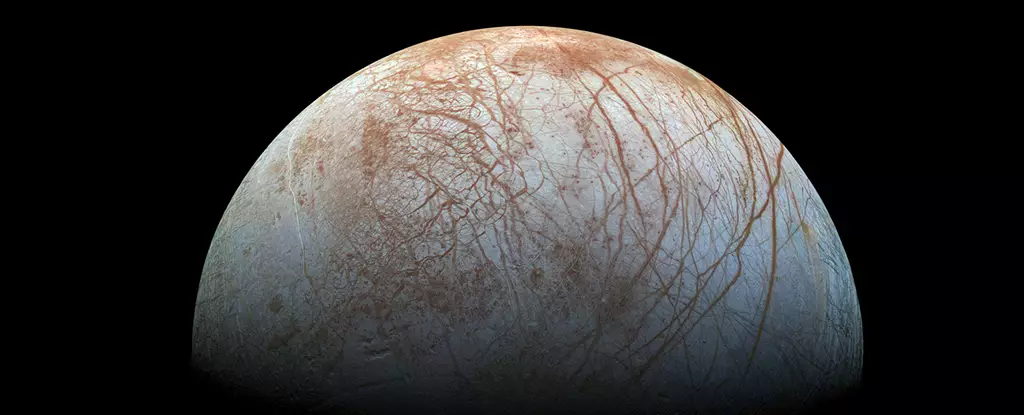In a groundbreaking revelation, astronomers have determined that carbon dioxide found on Jupiter’s moon Europa originates from its vast subsurface ocean. The detection of carbon dioxide on Europa’s surface has raised hopes of potentially finding extraterrestrial life in our Solar System. While scientists have long believed that Europa harbors a massive saltwater ocean beneath its icy surface, determining whether the chemical composition of this hidden ocean can sustain life has proven challenging. However, recent research utilizing data from the James Webb Space Telescope has shed new light on this intriguing moon.
Two independent teams of researchers, led by scientists from the United States, utilized near-infrared spectrometer data from the Webb telescope to map the distribution of carbon dioxide on Europa’s surface. The results of these studies were published separately in the journal Science. The researchers found that the highest concentrations of CO2 were located in a region called Tara Regio, spanning an area of 1,800 kilometers (1,120 miles). This region is characterized by chaotic terrain, featuring jagged ridges and cracks.
The origin of carbon dioxide on Europa has been a subject of considerable debate. One hypothesis suggests that warm water from the subsurface ocean rises to interact with the surface ice, resulting in the formation of chaotic terrain. The first study, led by Samantha Trumbo from Cornell University, concluded that the carbon dioxide on Europa is likely derived from the internal ocean. However, the researchers could not completely rule out the possibility that the carbon dioxide originated from the planet’s interior as carbonate minerals, which subsequently broke apart due to radiation, forming CO2.
Interestingly, the presence of table salt was also detected in the Tara Regio region, giving it a distinctive yellow hue compared to the rest of Europa’s plains. Scientists speculate that the salt may have emerged from the subsurface ocean as well. Samantha Trumbo commented, “So now we’ve got salt, we’ve got CO2: we’re starting to learn a little bit more about what that internal chemistry might look like.” These findings help researchers gain insights into the chemical composition of Europa’s hidden ocean, further fueling curiosity about the potential for life.
In addition to studying the carbon dioxide distribution, the second study, led by NASA, aimed to identify water plumes or volatile gases shooting out of Europa’s surface. However, the researchers were unable to detect any such emissions. Despite this setback, two ambitious missions are set to explore Europa and its enigmatic ocean in greater detail. The European Space Agency’s Jupiter moon probe Juice, launched in April, and NASA’s Europa Clipper mission, scheduled for October 2024, will provide unprecedented insights.
Project scientist Olivier Witasse, associated with the Juice mission, expressed excitement about the recent studies. Witasse deemed them “very exciting” and stated that when the Juice spacecraft flies past Europa twice in 2032, a wealth of new information will be collected, including surface chemistry data. The Juice mission also aims to study two other Jovian moons, Ganymede and Callisto, both of which have also exhibited carbon dioxide. However, it is crucial to note that the primary objective of these missions is to determine whether the icy moons possess conditions favorable for life, rather than confirming the existence of extraterrestrial organisms.
The discovery of carbon dioxide on Europa represents a significant advancement in our understanding of this intriguing moon and its potential to sustain life. Mapping the distribution of CO2 and the presence of table salt in the Tara Regio region provide valuable insights into Europa’s internal chemistry. As upcoming missions, such as Juice and the Europa Clipper, venture closer to this enigmatic moon, scientists eagerly await new revelations that could reshape our understanding of the possibilities for life beyond Earth.



Leave a Reply